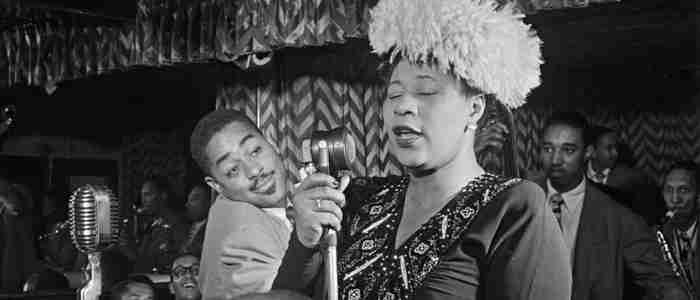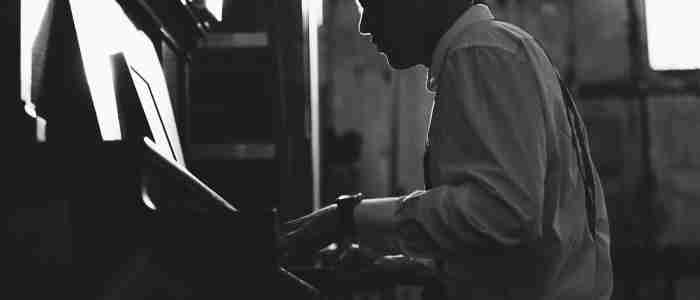How to Learn Jazz Improvisation: The Ultimate Guide
So you want to learn how to improvise jazz and that’s great, but where on Earth do you start jazz improvisation?!?! There’s so much information out there that figuring out where to begin playing jazz is a complete nightmare. But I’ll tell you this right now…If I could start jazz improvisation again today, I’d do my absolute BEST to learn jazz the same way that the greats of this music learned it…
The great jazz musicians didn’t have books filled with transcribed solos of their favorite players or The Real Book packed with sheet music to any jazz standard they wanted to learn. And they certainly didn’t have play along recordings or any sort of backing tracks that they could just pop in and jam with.
Sound crazy??
These resources like the Real Book and jazz play along sets are the primary practice tools people use to learn how to play jazz today…so if the masters of this music like Charlie Parker or John Coltrane didn’t use these, what did they use?
They learned to play jazz from listening to their heroes and building upon their findings with their own musical ideas.
They thought to themselves, “That’s interesting how Lester Young does that over the dominant 7th chord on the bridge off Rhythm Changes. Now, what can I do that’s interesting?”.
Then, they furthered their jazz improvisation knowledge by practicing, playing, and performing with others.
It’s really that simple when you boil it down.
Of course the convenience of playing with a play along recording can be fun, and learning jazz standards from a fake book is much easier than trying to figure out the chords from the recording yourself, but in the long run, materials like the Real Book and play along sets will actually distract you from the pathway that will get you to where you want to go.
And that may sound a bit daunting or counterintuitive to you, but the truth is that if you get started on the right track learning jazz improvisation, you’ll make gains way faster and skip YEARS of frustration that ensue from taking the shortcuts that most jazz education materials offer today.
Now that doesn’t mean you have to avoid all jazz education resources, but be careful about depending upon them as your main go-to knowledge for learning how to improvise. Most importantly, don’t interpret anything you learn from them as a rule or a cold-hard-fact.
There are always exceptions in music and different ways of looking at the same information. There is no one correct way, just one perspective among many.
The true answers to all of your jazz improvisation questions are on the recordings of the great masters, so even if you’re just starting to learn how to improvise, make sure that your focus remains on discovering knowledge by immersing yourself in the legendary jazz recordings and remember that the answers are right there in front of you every time you’re listening to this beautiful music…
15 Steps to Practicing Jazz Improvisation: A life-long Journey of Improvement
Learning how to improvise is not an overnight process. It’s a lifetime of practice, but that doesn’t mean you can’t rapidly improve and have a ton of fun in the process!
There is a TON of information here about learning how to improvise, so take your time and don’t feel overwhelmed. Yes there are many sides to learning this music, but that’s the fun of it. The journey of learning how to improvise never ends! There’s always something new to learn or something you’ll want to learn better.
The 15 steps laid out in this lesson will guide you through the necessary parts of the life-long journey of learning how to improvise better and better, giving you an overview of how to excel quickly and consistently at jazz improvisation.
But before we dive into the details of how to practice jazz and learn how to improvise jazz like a pro, let’s back up here for a second. After all, you’re drawn to this music for a reason: the way it SOUNDS…
Step 1: Start Listening to jazz like it’s your job
Load your phone with jazz and listen while you commute
Throw on some jazz in the background while you work
Dedicate focused time every day to checking out jazz musicians and jazz standards you haven’t heard before

The number one thing you can do to get started right now to learn how to improvise and constantly improve at jazz is to up your listening game. Sounds simple right?
But how much have you REALLY listened?
Now that we have phones that literally carry gigabytes of music, there’s no excuse not to be listening all the time. Invest in a high-quality set of ear-buds and listen to jazz whenever you possibly can. Subscribe to Apple Music or Spotify and have all the music you can imagine at your fingertips.
Fill your head with the stuff you like the most. When you wake up in the morning, on your way to work, while you work out, when you’re cooking dinner, when you’re cleaning up your house or doing laundry.
Listen, listen, listen, and then listen some more!!!
Start deepening your jazz improvisation listening skills with these lessons:
Active Listening: Learn how to do it and use it – Do you ever set aside dedicated time to just listen? How much are you connecting with the music? Does it really affect you, or have you been listening to jazz passively all this time? Use the jazz advice in this lesson to learn how to listen to music actively and become aware of what’s going on. Active listening is an extremely important step in improving your musicianship.
Listening advice you need to hear – Much of the time we listen to jazz just because we think we should listen to it and we kind of lump every recording of any jazz legend into the same bucket. But, like anything, there are great recordings and sub-par recordings. This article will talk about how to make sure you’re listening to the best of the best.
Why listening is crucial to learning jazz standards and improvising – Practicing jazz can seem pretty complex and often when we get to the practice room, we’re overwhelmed by even where to start. Here are 3 tricks that you can put into practice before you even enter the practice room and the first one is probably the most important. It’s all about listening.
Step 2: Understand the culture of jazz Improvisation
Learn the history of jazz and where it comes from
Read about the lives of jazz musicians to understand what life was like and how they expressed it in their music
Get the feeling and vibe of jazz so you don’t fall into the common trap of thinking of jazz as an intellectual art form

As you probably know, playing jazz requires quite a bit of knowledge. Everything from deep music theory to highly trained ears, but with all the incredible mental, visual, and aural skill needed, we often forget how DEEP this music really is.
A great way to connect with the lives of past jazz musicians and understand what life was like is to read the autobiographies or biographies of the jazz legends.
Pick one and read it to absorb the culture that these people lived in. Believe me, you’ll enjoy it. Reading about jazz musicians is always fun and entertaining, in fact, it can be down right haunting! Reading Art Pepper’s biography will give you chills…
Another great style of book to read is the making of historical albums. When you’re reading these kind of books, it’s as if you were in the recording studio watching as they put a legendary album together. There’s nothing quite like being a fly on the wall during the making of Kind of Blue.
And one final thing you’ll want to do is watch jazz interviews. Listening to how the greats thought about music, life, and practice will give you a deeper level of appreciation for jazz and get you excited and motivated to learn more.
Top Jazz Books and Lessons to learn jazz history and understand the deep jazz culture:
Miles: The Autobiography of Miles Davis – Although many people say that Miles made up a lot of it, this book is a great read and very entertaining. Even if you take a lot of what he says with a grain of salt – Miles, we all know you didn’t write Four or Donna Lee – it’s still worth checking out.
Straight Life: Art Pepper’s Biography – The first time I read this book, it transported me into another world. He describes every scene in his life with great detail, including his sexual exploits, intense drug addiction, and time in jail and rehab. This book is not for the lighthearted! It holds no punches, so be warned.
Good Morning Blues: The Autobiography of Count Basie – These are a compilation of Basie’s memoirs that were transcribed from tape recordings and assembled together. It’s pretty interesting as he shares his experiences as a traveling pianist in Missouri and Oklahoma.
I Walked With Giants: The Autobiography of Jimmy Heath – Tenor saxophonist Jimmy Heath knew many jazz giants such as Charlie Parker and played with other legends including John Coltrane, Miles Davis, and Dizzy Gillespie. In this extraordinary autobiography, the legendary Heath creates a dialogue with musicians and family members.
Thinking in Jazz: The Infinite Art of Improvisation – This book is fascinating. I pick it up from time to time and always find something interesting. It reveals how musicians, both individually and collectively, learn to improvise. Chronicling leading musicians from their first encounters with jazz to the development of a unique improvisatory voice, he documents the lifetime of preparation that lies behind the skilled improviser’s every idea.
ELLA: A Biography of the Legendary Ella Fitzgerald – ELLA chronicles the ultimate rags-to-riches embodiment of the American dream, whose personal life was one of the best-kept secrets in show business—until now.
Kind Of Blue: The Making Of The Miles Davis Masterpiece – This is one of my favorite books. With transcriptions of the unedited session tapes, in-depth interviews with musicians, freshly discovered Columbia Records files, never-before-seen photographs, and a foreword by the last surviving member of the band, drummer Jimmy Cobb, Kind of Blue is a vital piece of music history
A Love Supreme: The Story of John Coltrane’s Signature Album – Ashley Kahn tells the story of the genesis, creation, and aftermath of this classic recording. Featuring interviews with more than one hundred musicians, producers, friends, and family members, unpublished interviews with Coltrane and bassist Jimmy Garrison, and scores of never-before-seen photographs, A Love Supreme balances biography, cultural context, and musical analysis in a passionate and revealing portrait.
50 Jazz interviews to get you inspired – If you want to connect with the lives and culture of jazz musicians, there’s nothing like hearing them in their own words. These 50 jazz interviews will inspire you and shed a little light on the way they thought and lived.
Step 3: Understand what jazz improvisation actually is
Bust the myth that jazz improvisation is 100% made-up on the spot
Understand the crucial role of preparation in learning how to improvise
Learn the difference between practicing jazz and performing jazz

Do jazz improvisers create everything they’re playing on the spot. I mean, isn’t it completely 100% made up in the moment – that’s why it’s called improvisation, right?
Not exactly.
It is true that as an improviser you’re creating in the moment and , “seeing where things go,” but that doesn’t mean that it’s all made up on the spot…
The countless hours of preparation in the practice room give the improvisor musical tools that they can use in real-time. When they combine these tools, interact with the musicians around them, and let go, something new is born in that exact moment.
Learning how to improvise requires a balance between discovering, learning, and applying new concepts & jazz improvisation techniques, with the ability to relax and freely combine all the knowledge you have so you can “sing” new melodies through your instrument in real-time when you perform a jazz standard.
If that sounds a bit strange, that’s ok. It’s not exactly the easiest thing to understand in the process of learning to improvise. As a beginner, the best thing to do is to trust the process and have a crystal clear idea of what jazz improvisation actually is.
Top Lessons to understand what jazz improvisation actually is:
Is Jazz improvising really improvising? – When you’re first learning how to improvise jazz, it seems completely magical, as if everything is made up right on the spot, in the moment. But behind these seemingly spontaneous moment lie a ridiculous amount of preparation…
The Top 5 myths about playing jazz – It’s time to bust the top myths about jazz improvisation. Stop believing the hype and start realizing what’s fact and what’s fiction.
4 More myths about jazz improvisation – When it comes to jazz improvisation, there are plenty of myths. Check out this lesson to bust even more.
How thinking like a composer is essential to practicing jazz improvisation – The composer’s mindset it crucial to understanding the difference between what you think jazz improvisation is and what it actually is. When you realize that there’s more composition in improvisation, and more improvisation in composition, you’re on the right track.
Step 4: Understand how to practice jazz improvisation and how the pieces of the puzzle fit together
Learn what the various elements of practicing jazz are
Get an idea of how everything fits together
Realize that learning how to play jazz is a process, one that takes a long time, but is a constantly rewarding journey.

Why is practicing jazz improvisation so difficult?
One aspect of learning how to improvise that makes it so difficult is that it’s not linear. You might learn how to play over a minor 7 chord one day and then realize months later, you’ve encountered minor chords that don’t quite fit the model you have, or maybe you just get sick of how you play over minor chords and need a new approach, or perhaps you’re having trouble with certain keys of minor chords.
In learning how to improvise, there’s this constant flow of learning new material, learning old material better or completely reworking it, discovering new ways of combining ideas, or realizing there are huge gaps in your knowledge that need to be filled.
You’re always jumping around, pushing ahead to the new yet hopping backward to update, fix, and better understand the old.
Learning jazz is not linear, but the primary topics you need to tackle can fit into only a few categories. Having a conceptual idea of how all these practice categories fit together will help you understand how to practice jazz effectively and make rapid gains.
Top Lessons to understand how to practice jazz and how the pieces of practicing jazz improvisation fit together:
What to practice for jazz improvisation: A Free presentation on the elements of playing jazz – Learning what to practice when you want to play jazz can be difficult. Use this free jazz presentation to understand exactly what to practice to get better at playing jazz and how the fundamental pieces of practicing jazz improvisation fit together.
A Diagram on what to practice to play jazz – Having trouble getting specific in the practice room and spending your time the right way? Hang this free jazz practice diagram up in your practice room so you know what to practice and how to stay focused on what matters.
The Practice plan for getting good fast – The jazz advice in this lesson will show you how to learn jazz fast. Stick to this plan if you’re serious about learning how to improvise quickly.
Step 5: Start learning jazz theory but be careful!!!
Learn the 4 essential jazz chords, how they’re built, and how they function within a chord progression
Learn the essential jazz scales and how they relate to chords
Understand the dangers of theory, how it can cause years of frustration and derail your musical progress if used in the wrong way

When you open most guides to learning how to improvise, jazz scales and music theory almost always lead the way…
But this is a huge mistake!
Is jazz theory important? Of course! But it’s just ONE tool of many.
Definitely get started learning the basics of jazz theory, but know that the theory you learn is only one perspective on how to think about music. Despite what any book tells you, there’s no single RIGHT way to analyze or think about music. In fact, much of the creative music that you love is born from violating theoretical rules.
It’s called theory for a reason! Because theory is supposed to follow practice…
Use theory to support what you hear. If something is theoretically correct but doesn’t sound right, then it’s not. Keep working at it until it sounds good to you.
Jazz improvisation is NOT music theory and rules!
To begin playing jazz, there’s not that much music theory you need to understand. One of the primary things to focus on is learning and becoming comfortable with jazz chords and the 4 basic chord types:
The Definitive Guide to Jazz Chords – In this lesson you’ll get an overview of all the essential jazz chords. You’ll learn their structures, sounds, chord voicings and more…
Major 7 Chords – They seem easy, but playing something meaningful over them can actually be quite challenging
Minor 7 Chords – They can be approached differently depending upon the way they function within the key center
Dominant 7 Chords – These are tricky for people because they have so much variation depending on which notes are altered within the chord voicing
Half Diminished Chords (also known as minor 7 b5 chords) – They seem to present difficulty for nearly everyone because of there slightly foreign construction
Once you have a solid grasp on the 4 chord types, start to understand how the Chord Scale System relates scales to each chord and how you can use scales to understand how chords function within a key, how to approach a chord in a linear fashion instead of a vertical fashion, and how to easily access the upper structures of a chord, the 9th, 11th, 13th, but be careful thinking that scales are the secret to playing jazz.
Scales and theory can help a ton to conceptualize information in jazz, but remember, scales are just ONE tool in your toolbox.
Without the important tools that we’re about to cover – visualization, ear training, and jazz language – scales and theory will cause you years of frustration and you’ll constantly wonder why things still don’t sound the way you want them to.
A good rule of thumb: for any music theory study you do, make sure to spend an equal amount of time or more with famous jazz recordings transcribing, learning jazz language and chord changes. This guideline will ensure that your mental approach to music is balanced out with the actual sounds of jazz that you want to familiarize yourself with.
Top Lessons to learn the basics of jazz theory and what to watch out for:
Why scales are NOT the secret shortcut to learn how to play jazz – Scales are touted as the be-all-end-all in jazz education today. While they play an essential role in learning how to improvise, jazz scales are only one piece of the puzzle. They are not the secret shortcut that will make you a better improviser. Learn why now and save yourself from falling for this trap.
Get to know the Chord-Scale System: Benefits & Limitations – Expanding upon the limitations of thinking strictly in terms of scales, this lesson will help you understand how to get the most out the Chord Scale System without letting it put you into a musical straight jacket. Learn to get the benefits of this system without being held back by its limitations.
Understand the 3 different minor chords in a major key – Minor chords are actually more difficult for people than they even know because of the way they can function within a chord progression. Use this lesson to finally clear up the confusion behind how a minor 7 chord functions and how to simplify how you conceptualize these chords.
How to turn music theory into real music – Music theory is not music. But it does give you tools and guidelines for how to think about and classify elements of music. Given the right perspective you can learn to harness the power of music theory and transform it into real music.
Learn the subtleties of dominant 7 chord alterations – Altered dominant chords present quite the challenge to the beginning and intermediate improviser because they lack an understanding of the relationships within the structure of these chords. Use these visual references on alterations to dominant seventh chords to solidify how you think about these colorful chord tensions.
The Jazz Theory Unlocked Course – If you want to understand the WHY behind every chord in a tune, stop relying on scales for your theory understanding, and grow your harmonic understanding fast, then this course is for you.

Source: jazzadvice.com